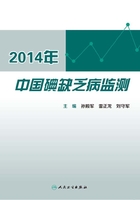
上QQ阅读APP看书,第一时间看更新
2014年辽宁省碘缺乏病病情监测报告
■ 王健辉 阚忠媛 刘长晟 辛玉梅 郑照霞 冯晓伟
(辽宁省疾病预防控制中心地方病所)
摘要
目的 了解辽宁省调整碘盐浓度后碘缺乏病防治效果,评估持续消除碘缺乏病进展。
方法 按人口比例概率抽样法抽取30个抽样县(市、区),单纯随机抽样方法在抽样县抽取1所小学,每个小学抽取50名8~10岁儿童,检查甲状腺容积,采集尿样和食用盐样品,检测尿碘和盐碘。在小学所在乡镇/街道抽取20名孕妇采集尿样和盐样,检测尿碘和盐碘。
结果 1520名儿童食用盐含碘量23.9mg/kg,碘盐覆盖率为98.9%(1503/1520),合格碘盐食用率94.3%(1433/1520),甲状腺肿大率1.8%(28/1520),儿童尿碘中位数159.1μg/L,达到了国家碘缺乏病消除标准且儿童尿碘水平适宜。621名孕妇食用盐含碘量23.5mg/kg,碘盐覆盖率为98.1%(609/621),合格碘盐食用率78.6%(488/621),尿碘中位数131.5μg/L,尿碘低于孕妇碘营养适宜水平的下限(150μg/L)。食用含碘量24~36mg/kg碘盐孕妇的尿碘中位数为147.4μg/L,更接近碘营养适宜水平;食用含碘量27~33mg/kg碘盐孕妇的尿碘中位数为167.5μg/L,达到碘营养适宜水平,且低尿碘孕妇比例显著降低。
结论 辽宁省碘缺乏病综合防治措施实施成效显著,省级水平保持了消除碘缺乏病状态。供应加碘量25mg/kg和30mg/kg的2个浓度碘盐设计合理,满足不同人群的碘营养需求,符合因地制宜、分类指导、科学补碘的碘缺乏病防治原则。建议适当降低食用盐含碘量的允许变异范围。
Abstract Objective To understand current situation of prevention and control of iodine deficiency disorders (IDD)after the concentration of iodized salt was adjusted, and to evaluate the progress in eliminating IDD in Liaoning provinces of China. Methods 30 county were sampled based on the sampling method of proportionate to population size.A primary school was selected in each county by the randomized sampling method, 50 students of 8-10 years old in each school were sampled for examining their thyroid volume, and tested their urinary iodine level and household salt iodine level.20 pregnant women were selected in each township near the location of these primary schools, and test their urinary iodine level and salt iodine level.Evaluation standards are as follows:The ultrasound was used to detect goiter size according to the diagnostic criteria for endemic goiter, goiter is the volume of thyroid greater than 4.5ml, 5.0ml and 6.0ml for 8, 9and 10 years old children and exclude hyperthyroidism, thyroiditis and thyroid neoplasms.Urinary iodine level of children:deficient is the median of urinary iodine (MUI) less than 100μg/L, adequate is MUI at 100-199μg/L, more than adequate is MUI at 200-299μg/L, and excessive is MUI equal to or greater than 300μg/L.Salt iodine:definition of qualified iodized salt of children is 25mg/kg±30%;non-iodized salt is iodine less than 5mg/kg;Unqualified iodized salt is iodine between 5-18mg/kg or higher than 33mg/kg.Definition of qualified iodized salt of pregnant women is 30mg/kg±30%;non-iodized salt is iodine less than 5mg/kg;Unqualified iodized salt is iodine between 5-21 mg/kg or higher than 39mg/kg. Results 1520 Children’s goiter rate was 1.8%which was obviously lower than the IDD elimination standard at the national level (below 5%);the iodized salt coverage rate was 98.9%and the consumption rate of qualified iodized salt was 94.3%.All figures had achieved the national standard.The mean of salt iodize content of 1520 children was 23.9mg/kg;MUI of children was 159.1μg/L.Urinary iodine of children was at adequate level.The mean of iodine content in the edible salt of 621 pregnant women is 23.5mg/kg, the rate of qualified iodized salt 78.6% (488/621),median urinary iodine was 131.5μg/L, and the level of iodine nutrition of pregnant women is lower than the optimum level limit (150μg/L) .The pregnant women edible iodized salt 24-36mg/kg of iodine content, the median urinary iodine were 147.4μg/L;the iodine content of edible iodized salt 27-33mg/kg of pregnant women, the median urinary iodine 167.5μg/L, reached the appropriate levels of iodine nutrition, and pregnant women of low urinary iodine significantly reduced. Conclusions Control measures implemented with remarkable results of iodine deficiency disease in Liaoning Province, IDD has been eliminated at the provincial level.25mg/kg or 30 mg/kg of iodine concentration iodized salt in design of supply reasonable to meet the needs of different groups for scientific iodine supplementation.
为进一步掌握《食用盐含碘量》(GB 26878—2011)实施后,碘缺乏病流行现状和防治措施落实情况,评估消除碘缺乏病的进展,依据《2014年公共卫生服务地方病防治项目实施方案》(中疾控地病发〔2014〕5号)和《2014年辽宁省地方病防治项目技术实施方案》(辽疾控函字〔2014〕210号)要求,辽宁省于2014年10月至2015年4月开展了碘缺乏病病情监测。现将监测结果报告如下。